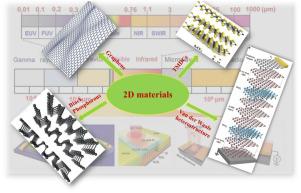当前位置:
X-MOL 学术
›
J. Ind. Eng. Chem.
›
论文详情
Our official English website, www.x-mol.net, welcomes your feedback! (Note: you will need to create a separate account there.)
State of the art two-dimensional materials-based photodetectors: prospects, challenges and future outlook
Journal of Industrial and Engineering Chemistry ( IF 6.1 ) Pub Date : 2020-09-01 , DOI: 10.1016/j.jiec.2020.06.009 Adeela Rehman , Soo-Jin Park
Journal of Industrial and Engineering Chemistry ( IF 6.1 ) Pub Date : 2020-09-01 , DOI: 10.1016/j.jiec.2020.06.009 Adeela Rehman , Soo-Jin Park

|
Abstract The study of light at the nanoscale, known as nanophotonics, has become a vibrant field of research. Recently, researchers are being focused to regulate the flow of light at length scales beyond the optical wavelength, mainly outstripping the classical limits constraints by diffraction. In this regard, two-dimensional (2D) and three-dimensional (3D) nanostructures sculpted from metallic and insulating materials can refract, filter, scatter, and process light in intriguing ways, never possible before in conventional materials and traditional geometries. This control over light-matter interaction at nanoscale has not only unveiled new phenomena but has also launched variety of novel applications, developing new strategies for integrated circuitry, energy harvesting and electro-optical technologies, establishing high expectations for future innovative discoveries.
中文翻译:

最先进的二维材料光电探测器:前景、挑战和未来展望
摘要 纳米级光的研究,即纳米光子学,已成为一个充满活力的研究领域。最近,研究人员正专注于在超过光学波长的长度尺度上调节光的流动,主要超出了衍射的经典限制。在这方面,由金属和绝缘材料雕刻而成的二维 (2D) 和三维 (3D) 纳米结构可以以有趣的方式折射、过滤、散射和处理光,这在传统材料和传统几何形状中是前所未有的。这种对纳米级光-物质相互作用的控制不仅揭示了新现象,而且还推出了各种新应用,为集成电路、能量收集和光电技术开发了新策略,
更新日期:2020-09-01
中文翻译:

最先进的二维材料光电探测器:前景、挑战和未来展望
摘要 纳米级光的研究,即纳米光子学,已成为一个充满活力的研究领域。最近,研究人员正专注于在超过光学波长的长度尺度上调节光的流动,主要超出了衍射的经典限制。在这方面,由金属和绝缘材料雕刻而成的二维 (2D) 和三维 (3D) 纳米结构可以以有趣的方式折射、过滤、散射和处理光,这在传统材料和传统几何形状中是前所未有的。这种对纳米级光-物质相互作用的控制不仅揭示了新现象,而且还推出了各种新应用,为集成电路、能量收集和光电技术开发了新策略,



























 京公网安备 11010802027423号
京公网安备 11010802027423号